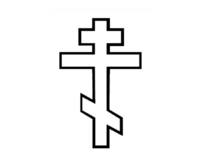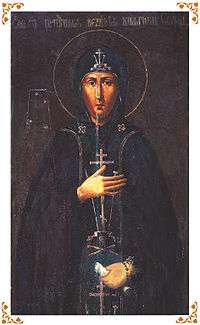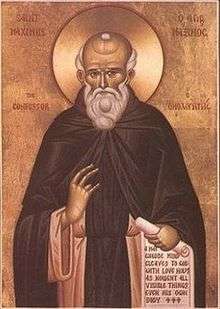August 1 (Eastern Orthodox liturgics)

July 31 - Eastern Orthodox liturgical calendar - Aug. 1
All fixed commemorations below are observed on August 14 by Orthodox Churches on the Old Calendar.[note 1]
For August 1st, Orthodox Churches on the Old Calendar commemorate the Saints listed on July 19.
Feasts
- Procession of the Precious Wood of the Life-giving Cross of Jesus Christ.[1][note 2]
- The Feast to the All-Merciful Saviour and the Most Holy Mother of God (especially in churches dedicated to Christ).[2][note 3][note 4]
- Beginning of the Dormition Fast.
Saints
- Holy Seven Maccabees:
- Holy Nine Martyrs of Perge in Pamphylia:
- Martyr Papas the New.[10][note 7]
- Martyr Eleazar.[11]
- Martyr Cyricus, by beheading.[12]
- Martyr Theodore, by the sword.[13]
- Martyr Polyeuctus, by being buried alive in manure.[14]
- Venerable Martyr Elessa of Kythira (375)[15][16]
- Saint Timothy of Proconnesus, Wonderworker, Archbishop of Proconnesus (6th century)[16][17]
Pre-Schism Western Saints
- Martyrs Menas, Menais, and others of England.[18][note 8]
- Child-martyr Justin, venerated in Louvre near Paris in France (c. 290)[7][19]
- Saint Nemesius, a saint venerated near Lisieux in France.[19][note 9]
- Saint Leus of Viguenza, a priest whose relics were honoured in Viguenza in Italy (4th century)[19]
- Saint Verus, Bishop of Vienne; he attended the Council of Arles in 314 (c. 314)[7][19]
- Saint Eusebius of Vercelli, Bishop (371)[16][note 10]
- Saint Exuperius of Bayeux, first Bishop of Bayeux in France, he is honoured in Corbeil (405)[19]
- Saint Ríoch, a nephew of St. Patrick, early Irish Christian missionary and Abbot of Innisboffin in Ireland (c. 490)[19]
- Saint Almedha (Eluned, Eled, Elevetha), suffered martyrdom on a hill near Brecon in Wales (5th century)[19]
- Saint Severus, a priest of noble family, famous for his charity, honoured from time immemorial in the village that bears his name, St Sever de Rustan (c. 500)[19]
- Saints Friard (Friardus of Vindumitta), and Secundel (Secundellus) deacon, hermits on the Isle of Vindomitte near Nantes in Gaul (c. 577)[16][19]
- Virgin-martyr Sidwell of Exeter (Sativola) (6th century)[20][note 11]
- Saint Kenneth (Cenydd, Kined), a hermit who made his cell among the rocks in the Gower peninsula in Wales at a place later called Llangenydd after him (6th century)[19]
- Saint Peregrinus, a pilgrim from Ireland who returning from a pilgrimage to the Holy Land settled as a hermit near Modena in Italy (643)[19]
- Saint Jonatus, a monk at Elnone in Belgium; Abbot of Marchiennes (c. 643-652) and then of Elnone Abbey (c. 652-659)[19]
- Saint Mary the Consoler, sister of St Anno, Bishop of Verona in Italy (8th century)[19]
- Saint Æthelwold of Winchester, Bishop of Winchester (984)[7][16][22]
Post-Schism Orthodox Saints
- Saint Davyd Sviatoslavich, Prince of Chernigov (1097–1123)[3] (see also December 27)
New Martyrs and Confessors
- New Hieromartyr Basil, Archbishop of Chernigov (1918)[2][20]
- New Hieromartyr Demetrius Pavsky, Priest (1937)[20][23]
Other commemorations
- Baptism of Rus' (1 August 988)
- Finding of the relics (1882) of Bishop Nestor (Zakkis)[note 12] of the Aleutians and Alaska (1882)[16]
- Repose of Abbess Alexia of Nizhni-Novgorod (1940)[16]
- Uncovering of the relics (1995) of the Venerable Sophia of Suzdal (1542)[20]
Icon Gallery
-

The Holy Seven Maccabees, their mother Solomonia, and their teacher Eleazar (Russian veil icon, 1525).
-

St. Eusebius of Vercelli. By Richard de Montbaston (14th century).
-

St. Sidwell of Exeter. Relief, on a shopping arcade in Sidwell Street, Exeter.
-
St. Cenydd's (Kenneth's) Church, Llangennith.
-

Saint Sviatoslav II of Kiev (far right), with his family.
-

Fresco depicting the Baptism of the Kievan Rus'.
-
.jpg)
Bishop Nestor (Zakkis) of the Aleutians and Alaska.
-

Venerable Sophia of Suzdal (Solomonia Saburova).
Notes
- ↑ The notation Old Style or (OS) is sometimes used to indicate a date in the Julian Calendar (which is used by churches on the "Old Calendar").
The notation New Style or (NS), indicates a date in the Revised Julian calendar (which is used by churches on the "New Calendar"). - ↑ In the Greek Chasoslov (Horologion) of 1897 is explained thus the derivation of this feast: "By reason of the sicknesses, often everywhere occurring in August, from of old customarily it was done at Constantinople to carry out the Venerable Wood of the Cross along the roads and streets for the sanctifying of places and for the driving away of sicknesses. On the eve (July 31), carrying it out from the imperial treasury, they placed it upon the holy table of the Great Church (in honour of Saint Sophia – the Wisdom of God). From this feastday up to the Dormition of the Most Holy Mother of God, making litia throughout all the city, they then placed it forth for all the people to venerate. This also is the Issuing-forth of the Venerable Cross". In the Russian Church this feast is combined also with a remembrance of the Baptism of Rus', on 1 August 988.
- ↑ The Feast to the All-Merciful Saviour and the Most Holy Mother of God was established on the occasion of portents from icons of the Saviour, the Most Holy Mother of God and the Venerable Cross during the time of a battle of holy Prince Andrei Bogoliubsky (1157-1174) with the Volga Bulgars in 1164. This is the first of three feast days of the All-Merciful Saviour, celebrated in August. The second – is the Transfiguration (Preobrazhenie, Metamorphosis) of our Lord God and Saviour Jesus Christ (commemorated August 6). The third – is the Transfer from Edessa to Constantinople of the Not-Wrought-by-Hand Image of the Lord Jesus Christ (commemorated August 16, during the Afterfeast of the Dormition of the Most Holy Mother of God). These three feasts, as it were, connect together the Dormition-Uspenie Fast.
- ↑ This is the first of the three feasts of the Saviour or “Spasy” in August and is popularly called the “Honey Saviour/Spas” in Ukraine because during this time beekeepers harvest honey and hold honey markets – such as the famous one at the Kyiv Caves Lavra to this day. It marks the exact day on which St Volodymyr the Great officially baptized his people, receiving Orthodox Christianity in 988, even though today that event is commemorated by Ukraine on St Volodymyr’s day. On this day water is therefore blessed. The Cross is venerated marking the victory of the armies of Rus’ over the Volga Bulgars. The feast is also called that of “the Merciful Saviour and of the Most Pure Theotokos.”[3]
- ↑ "At Antioch, the martyrdom of the seven holy brothers, the Machabees, and their mother, who suffered under king Antiochus Epiphanes. Their relics were transferred to Borne, and placed in the church of St. Peter, just mentioned". (i.e. Church of St. Peter in Chains).[7]
- ↑ "At Pergen, in Pamphylia, the holy martyrs Leontius, Attius, Alexander, and six husbandmen, who were beheaded in the persecution of Diocletian, under the governor Flavian."[7]
- ↑ Tied in a sack and drowned at sea; (Greek) «Εἰς σάκκον βληθεῖς, καὶ θίβη ἐγκλεισθεῖς, καὶ εἰς θάλασσαν ριφθεῖς, τελειούται».
- ↑ The Greek Synaxarion says that they were martyred:
- "in Viglentius, near the copper tetrapyle" (four-way arch);
- (Greek) "ἐν τῷ Βιγλεντίῳ, πλησίον τοῦ χαλκοῦ Τετραπύλου".
- ↑ "In the territory of Liswin, St. Nemesius, confessor."[7]
- ↑ "At Vercelli, St. Eusebius, bishop and martyr, who for the confession of the Catholic faith, was banished to Scythopolis and thence to Cappadocia by the emperor Constantius. Afterwards returning to his church, he suffered martyrdom in the persecution of the Arians. His feast is kept on the 16th of December."[7]
- ↑ "The sacred remains of ST. SlDWELL, Virgin and Martyr, were buried in the church which still bears her name, outside the walls of Exeter. St. Sidwell, also called SATEVOLA and SlTHEFULLY, is said to have lived about the year 700, and to have been of an ancient British family. She had three sisters, also venerated as Saints - Juthwara (whose translation was celebrated at Shirburn on the 13th July), Edware, and Willgith."[21] Her feast day is variously given as July 31, August 1 or August 2.
- ↑ See also: (Russian): Нестор (Засс). (Russian Wikipedia).
References
- ↑ Procession of the Honorable Wood of the Life-Giving Cross of the Lord (First of the three "Feasts of the Savior" in August). OCA - Feasts and Saints.
- 1 2 The Autonomous Orthodox Metropolia of Western Europe and the Americas (ROCOR). St. Hilarion Calendar of Saints for the year of our Lord 2004. St. Hilarion Press (Austin, TX). p.56.
- 1 2 Dr. Alexander Roman. August. Calendar of Ukrainian Orthodox Saints (Ukrainian Orthodoxy - Українське Православ'я).
- ↑ Martyr Solomonia the mother of the Holy Seven Maccabee Martyrs. OCA - Feasts and Saints.
- ↑ Great Synaxaristes: (Greek) Οἱ Ἅγιοι Ἑπτὰ Μακαβαίοι. 1 Αυγούστου. ΜΕΓΑΣ ΣΥΝΑΞΑΡΙΣΤΗΣ.
- ↑ 7 Holy Maccabee Martyrs. OCA - Feasts and Saints.
- 1 2 3 4 5 6 7 The Roman Martyrology. Transl. by the Archbishop of Baltimore. Last Edition, According to the Copy Printed at Rome in 1914. Revised Edition, with the Imprimatur of His Eminence Cardinal Gibbons. Baltimore: John Murphy Company, 1916. pp. 228-229.
- ↑ Great Synaxaristes: (Greek) Οἱ Ἅγιοι ἐννέα Μάρτυρες. 1 Αυγούστου. ΜΕΓΑΣ ΣΥΝΑΞΑΡΙΣΤΗΣ.
- ↑ Martyr Leontius of Perge in Pamphylia. OCA - Feasts and Saints.
- ↑ Great Synaxaristes: (Greek) Ὁ Ἅγιος Πάπας ὁ νέος. 1 Αυγούστου. ΜΕΓΑΣ ΣΥΝΑΞΑΡΙΣΤΗΣ.
- ↑ Great Synaxaristes: (Greek) Ὁ Ἅγιος Ἐλεαζάρος ὁ Μάρτυρας. 1 Αυγούστου. ΜΕΓΑΣ ΣΥΝΑΞΑΡΙΣΤΗΣ.
- ↑ Great Synaxaristes: (Greek) Ὁ Ἅγιος Κήρυκος ὁ Μάρτυρας. 1 Αυγούστου. ΜΕΓΑΣ ΣΥΝΑΞΑΡΙΣΤΗΣ.
- ↑ Great Synaxaristes: (Greek) Ὁ Ἅγιος Θεόδωρος ὁ Μάρτυρας. 1 Αυγούστου. ΜΕΓΑΣ ΣΥΝΑΞΑΡΙΣΤΗΣ.
- ↑ Great Synaxaristes: (Greek) Ὁ Ἅγιος Πολύευκτος ὁ Μάρτυρας. 1 Αυγούστου. ΜΕΓΑΣ ΣΥΝΑΞΑΡΙΣΤΗΣ.
- ↑ Great Synaxaristes: (Greek) Ἡ Ἁγία Ἐλέσα ἡ Ὁσιομάρτυς. 1 Αυγούστου. ΜΕΓΑΣ ΣΥΝΑΞΑΡΙΣΤΗΣ.
- 1 2 3 4 5 6 7 August 1/14. Orthodox Calendar (PRAVOSLAVIE.RU).
- ↑ Great Synaxaristes: (Greek) Ὁ Ἅγιος Τιμόθεος ὁ Θαυματουργός Ἀρχιεπίσκοπος Προκοννήσου (Προικοννήσου). 1 Αυγούστου. ΜΕΓΑΣ ΣΥΝΑΞΑΡΙΣΤΗΣ.
- ↑ Great Synaxaristes: (Greek) Οἱ Ἅγιοι Μήνης (ἢ Μηνός) καὶ Μηναῖος καὶ οἱ λοιποὶ ἐν τῷ Βιγλεντίῳ, πλησίον τοῦ χαλκοῦ Τετραπύλου. 1 Αυγούστου. ΜΕΓΑΣ ΣΥΝΑΞΑΡΙΣΤΗΣ.
- 1 2 3 4 5 6 7 8 9 10 11 12 13 August 1. Latin Saints of the Orthodox Patriarchate of Rome.
- 1 2 3 4 August 14 / August 1. HOLY TRINITY RUSSIAN ORTHODOX CHURCH (A parish of the Patriarchate of Moscow).
- ↑ Rev. Richard Stanton. A Menology of England and Wales, or, Brief Memorials of the Ancient British and English Saints Arranged According to the Calendar, Together with the Martyrs of the 16th and 17th Centuries. London: Burns & Oates, 1892. pp. 375-377.
- ↑ Great Synaxaristes: (Greek) Ὁ Ἅγιος Ethelwald (Ἀγγλοσάξωνας). 1 Αυγούστου. ΜΕΓΑΣ ΣΥΝΑΞΑΡΙΣΤΗΣ.
- ↑ (Russian) 1 августа (ст.ст.) 14 августа 2013 (нов. ст.). Русская Православная Церковь Отдел внешних церковных связей. (DECR).
Sources
- August 1/14. Orthodox Calendar (PRAVOSLAVIE.RU).
- August 14 / August 1. HOLY TRINITY RUSSIAN ORTHODOX CHURCH (A parish of the Patriarchate of Moscow).
- Complete List of Saints. Protection of the Mother of God Church (POMOG).
- August 1. OCA - The Lives of the Saints.
- Dr. Alexander Roman. August. Calendar of Ukrainian Orthodox Saints (Ukrainian Orthodoxy - Українське Православ'я).
- August 1. Latin Saints of the Orthodox Patriarchate of Rome.
- The Roman Martyrology. Transl. by the Archbishop of Baltimore. Last Edition, According to the Copy Printed at Rome in 1914. Revised Edition, with the Imprimatur of His Eminence Cardinal Gibbons. Baltimore: John Murphy Company, 1916. pp. 228–229.
- Rev. Richard Stanton. A Menology of England and Wales, or, Brief Memorials of the Ancient British and English Saints Arranged According to the Calendar, Together with the Martyrs of the 16th and 17th Centuries. London: Burns & Oates, 1892. pp. 375–377.
Greek Sources
- Great Synaxaristes: (Greek) 1 ΑΥΓΟΥΣΤΟΥ. ΜΕΓΑΣ ΣΥΝΑΞΑΡΙΣΤΗΣ.
- (Greek) Συναξαριστής. 1 Αυγούστου. ECCLESIA.GR. (H ΕΚΚΛΗΣΙΑ ΤΗΣ ΕΛΛΑΔΟΣ).
Russian Sources
- (Russian) 14 августа (1 августа). Православная Энциклопедия под редакцией Патриарха Московского и всея Руси Кирилла (электронная версия). (Orthodox Encyclopedia - Pravenc.ru).
- (Russian) 1 августа (ст.ст.) 14 августа 2013 (нов. ст.). Русская Православная Церковь Отдел внешних церковных связей. (DECR).
